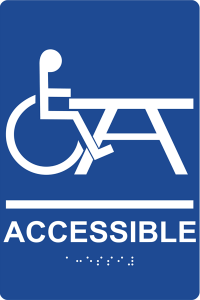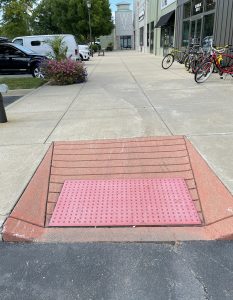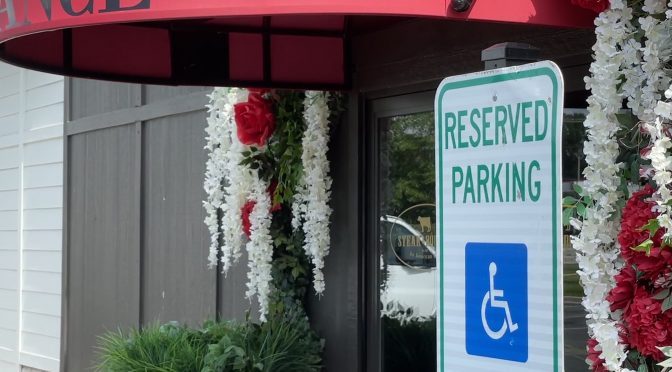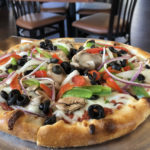By Robin Garr
LouisvilleHotBytes.com
“With today’s signing of the landmark Americans for Disabilities Act,” intoned President George H.W. Bush in March 1990, “every man, .woman, and child with a disability can now pass through once-closed doors into a bright new era of equality, independence, and freedom.” The ADA promised access for disabled people to public accommodations such as restaurants.
Now, 31 years after Bush’s glowing promise, how’s that working out for disabled diners in Louisville restaurants?
I’ve included brief observations about the restaurant’s accessibility in each dining-in review since March 2018. During that time I’ve gauged the state of restaurant access as pretty good, certainly not perfect; and I’ve discovered how much I don’t even notice from my able-bodied perspective.

Is that door too narrow for a standard wheelchair? Oops, didn’t notice that. Yes, the men’s room has grab bars over the toilet, but are they installed properly? I’m not sure. Is the ramp too steep? The door too heavy? And then there’s the separate set of issues that blind or deaf diners face.
Hoping to learn more, I talked about access with a dozen local disabled people who enjoy dining out, and a couple of restaurateurs who are eager to serve them.
Talks with disabled people made clear that President Bush’s hopeful forecast has borne some fruit: Certainly it’s easier to get into and around restaurants and other businesses – particularly new construction – than it was 30 years ago. Most new restaurants offer a level, easily negotiated front entrance. But problems persist with some older buildings.
In short, the world remains full of small barriers and a few large ones, rarely structural but most often easily corrected, or even the result of actions as careless as leaving a chair partly blocking a restroom door.
“The biggest culprit in many restaurants is usually access to the restrooms,” said Laura Busse McGarity, co-owner of The Fat Lamb restaurant and design manager at ID_A Inc., Interior Design and Architecture, where her work includes advising clients on ADA compliance. “Things get stacked up and impede the way.”

And that’s just the beginning. Ask six disabled people what small thing would help access, and get a half-dozen good answers.
- Start at the front door: A door that’s heavy and hard to open is a problem for everyone. And never forget: “Just one step” is still one too many for a wheelchair user, and an offer to help lift the chair and user over isn’t always readily available and may risk an accident.
- Make sure that there’s a smooth path from the reserved parking spaces to the restaurant’s front door. Brick pavement, broken sidewalks, high curbs and the like may prompt a potential diner to head for a new suburban eatery instead.
- Don’t cram tables together so tightly that a person in a wheelchair can’t negotiate the spaces between them. Pandemic table distancing actually shows the space that a wheelchair user needs.
- If the accessible entrance must be through a separate door, make that clear with a sign at the main entrance. Then, try not to direct wheelchair users through bumpy, dark alleys to a rear entrance through the kitchen.
- It’s not just about wheelchairs: Guests who use a walker or a cane will want a clear path and a convenient way to stash them nearby.
- Don’t forget, sight and hearing impairments are covered by ADA too! Technology offers new opportunities for blind customers with screen-reading apps that can scan text and read it aloud; but this only works if the original document is clear, said Rick Roderick, who is blind and hearing impaired. Text as graphic images or PDFs not created as text can’t be read at all, he said. QR codes that open menus on one’s smart phone (also a no-touch feature for the pandemic) are helpful, but they must point to accessible text.
- Even older people whose vision isn’t what it used to be will love clear menus and sufficient lighting, McGarity said. Fat Lamb’s servers will bring a small table lamp for anyone who’s struggling.
- Noise and loud music may herald a lively scene, but make it impossible for hearing-impaired guests and difficult for everyday people. Turn down the sound, if feasible, or at least try to keep a quiet corner available on request.
“Restaurant owners don’t have malicious intent,” McGarity said, “but they’re not trained to understand. Those who do it well may have someone in their life with a disability, so they know.
“The overarching thing is, yes we have ADA, basic requirements that you have to have. Turning radiuses, a clear approach to the table. But there are so many small things that make a big difference in the user experience.”?? A few examples: Levers are easier for everyone to turn than doorknobs. The ADA allows a half-inch difference in level between tile and carpet, but that’s enough to catch a cane or walker or trip someone who’s carelessly shuffling along. And having a tablecloth the same color as the floor invites a guest with poor vision to drop their glass off the edge of the table.
“The big thing for everyone,” McGarity said, “is that designing for people with disabilities is universal design. It’s not just good for people with disabilities, it’s good for everyone. It’s not like doing this is going to be bad for other people.”




